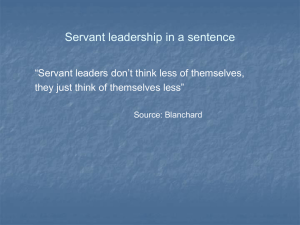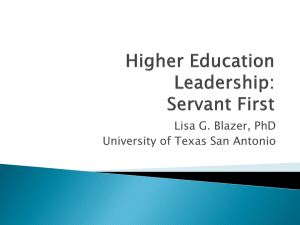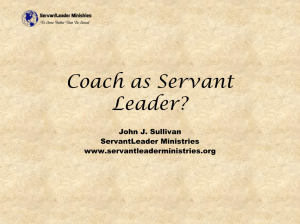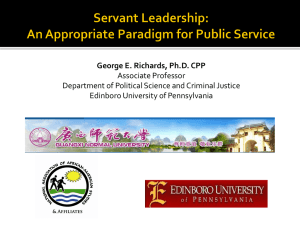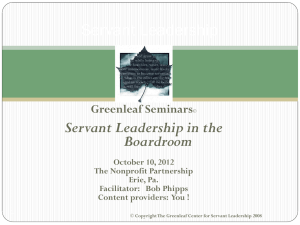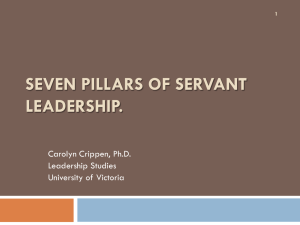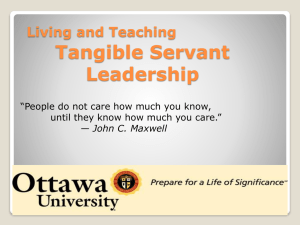Opening Keynote: Two Leadership Styles Worth Considering
advertisement
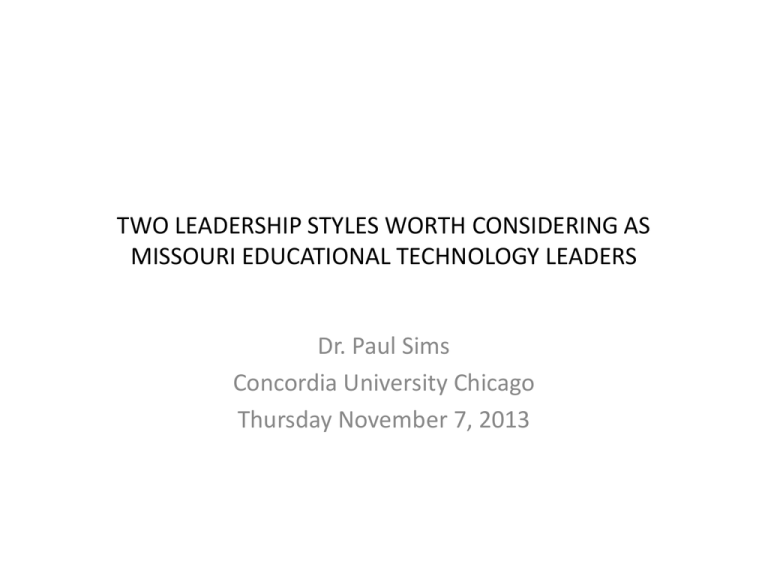
TWO LEADERSHIP STYLES WORTH CONSIDERING AS MISSOURI EDUCATIONAL TECHNOLOGY LEADERS Dr. Paul Sims Concordia University Chicago Thursday November 7, 2013 KWL • Please complete the following KWL chart in your packet Topic: What do you know about yourself as a Missouri Educational Technology Leader? What I Know What I Want to Know What I Learned OBJECTIVES • By the end of this session, you will be able to: • 1). Cleary identify what leadership means to you. • 2). Evaluate yourself as a servant leader: do I have what it takes? • 3). Create a profile of your moral leadership considering the whole person, motivation and sources of authority. WHAT IS LEADERSHIP? • How do you define “leadership?” • Give an example of a good leader? What does she or he do and say? • Give an example of a bad leader? What does he or she do and say? • What does leadership mean for you as a Missouri Educational Technology Leader? WHAT IS LEADERSHIP? For each of the following letters, fill in the qualities or skills of leaders: • • • • • • • • • • L E A D E R S H I P WHAT IS LEADERSHIP? • “Leadership is the process of influencing group activities toward the achievement of goals.” (Bass and Ovolio, 1993) • “Leadership is influencing, guiding in direction, course, action, and opinion.” (Bennis and Nanus, 1985) • “Leadership is effective influence.” (Argyris, 1976) • “Leadership is building cohesive and goal-oriented teams.” (Clark, Clark and Campbell, 1993) • “Leadership is persuading others to sublimate their own self interests and adopt the goals of a group as their own.” (Block, 1993) Leadership • • • • Thoughts on Leadership handout. Discuss with a partner. Tips on Leadership Parts of the Body What do we want in a leader? • “Our chief want is to find someone to inspire us to be what we know we could be.” • Ralph Waldo Emerson Theoretical Framework Supporting this Talk is the Concept of: Servant Leadership Greenleaf, 1970 Moral Leadership Sergovanni, 1992 Servant Leadership • The concept of servant leadership was first introduced by Robert K. Greenleaf in 1970 and has reaped success for companies such as Southwest Airlines, ServiceMaster Company, U.S. Cellular and TTI Industries. • Greenleaf wrote that a servant leader carefully makes sure that the highest priority needs of others are being met, leading to those people becoming "healthier, wiser, freer, more autonomous, more likely themselves to become servants. Servant Leadership The servant-leader is servant first… It begins with the natural feeling that one wants to serve, to serve first. Then conscious choice brings one to aspire to lead. That person is sharply different from one who is leader first, perhaps because of the need to assuage an unusual power drive or to acquire material possessions…The leader-first and the servant-first are two extreme types. Between them there are shadings and blends that are part of the infinite variety of human nature.” Servant Leadership The difference manifests itself in the care taken by the servant-first to make sure that other people's highest priority needs are being served. The best test, and difficult to administer, is: Do those served grow as persons? Do they, while being served, become healthier, wiser, freer, more autonomous, more likely themselves to become servants? And, what is the effect on the least privileged in society? Will they benefit or at least not be further deprived?” Servant Leadership • Servant Leadership is not about a personal quest for power, prestige, or material rewards. Instead, from this perspective, leadership begins with a true motivation to serve others. Rather than controlling or wielding power, the servant-leader works to build a solid foundation or shared goals by (1) listening deeply to understand the needs and concerns of others; (2) working thoughtfully to help build a creative consensus; and (3) honoring the paradox of polarized parties and working to create ‘third right answers’ that rise above the compromise of ‘we/they’ negotiations. Servant Leadership The focus of Servant Leadership is on sharing information, building a common vision, selfmanagement, high levels of interdependence, learning from mistakes, encouraging creative input from every team member, and questioning present assumptions and mental models.“ What do Servant Leaders do? • Devote themselves to serving the needs of organization members. • Focus on meeting the needs of those they lead. • Develop employees to bring out the best in them. • Coach others and encourage their self expression. • Facilitate personal growth in all who work with them. • Listen and build a sense of community. CHARACTERISTICS OF SERVANT LEADERSHIP: DO YOU HAVE A SENSE OF THESE AS A MISSOURI EDUCATIONAL TECHNOLOGY LEADER? 1. 2. 3. 4. 5. 6. 7. 8. 9. 10. 11. 12. Calling Listening Empathy Healing Awareness Persuasion Conceptualization Foresight Stewardship Growth Building Community Servant Leadership Development REFERENCES • Block, P. (1996). Stewardship: Choosing service over self-interest. San Francisco: Berrett-Koehler Publishing. • Greenleaf, R. K. (1977). Servant Leadership: A journey into the nature of legitimate power and greatness. New York: Paulist Press. • Spears, L. C. (1995). Reflections on leadership: How Robert K. Greenleaf's Servant Leadership influenced today's top management thinkers. New York: Wiley Press. MORAL LEADERSHIP • The HEART OF LEADERSHIP Has to do with what a person believes, values, dreams about and is committed to, the person’s personal vision. It is the person’s interior world, which becomes the foundation of his or her reality. MORAL LEADERSHIP • The HEAD OF LEADERSHIP The head of leadership has to do with mindscapes or theories of practice that leaders develop over time to reflect on the situations they face. MORAL LEADERSHIP • The HAND OF LEADERSHIP The hand of leadership is my decisions, actions and behaviors. MORAL LEADERSHIP • As Missouri Educational Technology Leaders, how do we balance the needs of the: • HEART • HEAD • HEART ? MORAL LEADERSHIP • • • • Three Rules of Motivation: A). What gets rewarded get done. B). What is rewarding gets done. C). What is good gets done. • What motivates us? • What inspires us? WHAT SOURCES OF AUTHORITY DO WE PRACTICE? • 1). Bureaucratic Authority: we implement mandates from the school or district. • 2). Psychological Authority: we build relationships with teachers/ school leaders. • 3). Technical-Rational Authority: we identify best practices and teacher teachers/ school leaders how to do it. WHAT SOURCES OF AUTHORITY DO WE PRACTICE? • 4). Professional Authority: we promote dialogue with teachers/ school leaders to state professional values and accepted tenets of practice. • 5). Moral Authority: we identify the core values and beliefs that define the center of the school as a community of learners. KWL • Please complete the following KWL chart in your packet Topic: What do you know about yourself as a Missouri Educational Technology Leader? What I Know What I Want to Know What I Learned

